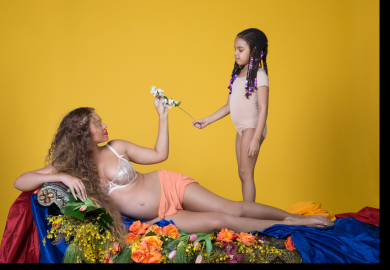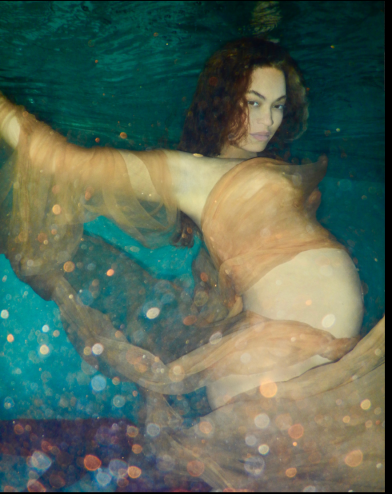The Perceptions of Pregnancy blog, like the Researchers’ Network, aims to reach beyond boundaries and borders, and to facilitate an international and interdisciplinary conversation on pregnancy and its associated bodily and emotional experiences from the earliest times to the present day. This weeks post is part two of Chelsea Phillips’ conversation about Beyonce’s recent pregnancy photo shoot.
On 1 February 2017, Beyoncé Knowles-Carter announced that she was pregnant with twins on Instagram, sparking a social media frenzy. The initial image was quickly revealed to be part of a photo shoot by the artist Awol Erizku. In early April, I sat down with a group of friends and colleagues to discuss the shoot: art historian Tim McCall, performer and playwright James Ijames, and pop culture maven Ashley Leamon joined me.
What follows is Part Two of that conversation. You can read Part One here.
Chelsea: Let’s take a look at some of the others with that strong yellow background.
James: The formality of the body is striking.

Beyonce Chaise Photo Credit: Awol Erizku.
Tim: It’s kind of a flip of Le Grand Odalisque. It’s definitely the kind of bed from Titian’s Venus of Urbino, but the arms are different.
Ashley: It’s also a little Kate Winslet from Titanic.

Le Grand Odalisque by Jean-Auguste Dominique Ingres (1814)]
Tim: She’s definitely not any of the five or six most famous reclining nudes exactly; it’s closest to Odalisque, but it’s flipped.
Chelsea: So she’s recalling genres or clusters of things, but not recreating anything?
Tim: Emulating but not imitating.

Venus of Urbino, Titian (1536-38)
James: This one with Blue feels Egyptian to me; the body looks like a hieroglyph.
Tim: It also looks like the Creation of Adam, with Blue as God giving her life.

Photo Credit: Awol Erizku.
Tim: It also looks like the Creation of Adam, with Blue as God giving her life.

Michelangelo, The Creation of Adam (1508-1512)
Chelsea: It’s also—not spatially, really since there’s usually some space—but a bit like an Annunciation, bringing the flower to the Virgin Mary to announce her pregnancy. *
James: These also remind me of Mickelane Thomas; she almost exclusively paints black women in repose; and the frame is always incredibly full, really really full, almost too much to take in. One is on the cover of a book of poetry by Morgan Parker called, “There are things in the world more beautiful than Beyoncé.” [Update, November 2017: check out Artsy’s current exhibit, featuring Mickelane Thomas!]
Tim: That’s an audacious claim to make.
James: It’s fabulous poetry—so I can’t get angry about it. It’s amazing poetry.
Chelsea: Let’s look at something underwater.

Photo Credit: Awol Erizku.
Chelsea: James, both Oshún and Yemeya are Yoruba goddesses associated with water, right?
James: Yes, and Yemaya is salt water, so she’s oceans and seas, and Oshún is rivers, sweet waters, ponds. Oshún is the Venus of the group.
Tim: And Venus is water too; Uranus’ testicles were cut off and she was born virginally from the foam.
James: That’s right. Oshún is also abundance and fertility.

Oshún and Yemaya, Artist Unknow
Chelsea: I love the image from the poem she posted with the shoot, which refers to creating flowers wherever she walks.
I was reading about her outfit for the Grammys, and how strongly she was channeling Oshún, especially with the crown and the use of gold. And of course there’s that really strong yellow from Lemonade; Osún also smiles while she destroys, which Beyoncé does in “Hold Up.”
Ashley: People have been speculating that’s she’s wearing pink, blue, and green in the first photo to avoid being gender-specific, and yellow is another neutral color. But the latest thing, she was wearing the same pair of earrings she wore in a video—
James: “If I Were a Boy.”
Ashley: Yeah, which made everyone think they were boys.
James: Everyone is always trying to figure out what she‘s doing. But she’s still very private. I think she’s trying to make the point that celebrity doesn’t require your entire life. She commands quite a lot.
Ashley: A lot of pregnant celebrities go on lockdown when they’re pregnant. They might make a few appearances that are very—styled—but otherwise they stay private throughout that process.
Chelsea: Celebrity bodies are always considered public property. But we also tend to think of pregnant bodies as public bodies, “Oh, you’re pregnant?” Then I can touch you. I can ask you invasive questions, and tell you what to do. Because I see your body and I know how to read it, and what it means, I feel like I get to say something about it.
Who would want to deal with a double dose of that if you could avoid it?
Tim: So she’s in a couple different moral economies with everyone policing her.
Chelsea: Exactly. Like the #BoycottBeyonce thing after the Super Bowl; everything she does is done as a celebrity, so it always has greater value—she must sanction this, believe this, want her fans to do this.
James: The #BoycottBeyonce thing is a really good example, because she’s so smart about controlling her own narrative. She’ll do something and get pushback, and then she makes up a bunch of t-shirts that say #BoycottBeyonce and sells them at her concerts.
She’s really good at saying, “this will happen on my terms, no matter the pushback.” And I don’t know too many celebrities who get to do that right now.
Tim: The President. Controlling the narrative.
Chelsea: In so many of these photos she’s looking right out at us—she sees us; she’s allowing us to look at her on her own terms. This isn’t a candid on the cover of a tabloid “is Beyonce pregnant?” It’s “Yes I am, and I will be accorded the status Mother of the World and the Virgin Mary, and goddess of love and fertility of any and all traditions.”
Ashley: She’s posting pictures from her earlier pregnancy too, and at the time there was nothing.
Chelsea: Correcting the narrative maybe—not only is my body definitely my body and pregnant, but now I’m going to go back and clear up that earlier narrative that I didn’t have as much control over [read more in part one. ].
Tim: The gaze is one of the most audacious things about the Venus of Urbino; she’s looking at us, not asleep, no downcast eyes. And the Virgin Mary, she’s one of the only people in Medieval art who looks out at us.

Detail of Venus of Urbino
For 80 years, men look at us and women are in profile when they are paired, and then eventually women begin to look out.
*Note: After our talk, I came across a number of other resonances between this piece and more contemporary artists, including Alice Neel’s Pregnant Maria; and, in the inclusion of another figure, Jan Banning’s Danae Olympia, from her National Identities series, itself inspired by Manet’s Olympia and Rembrandt’s Danae
Chelsea Phillips is Assistant Professor of Theatre; I study pregnancy, eighteenth century theatre, and celebrity and Associate Director of the Perceptions of Pregnancy Research Network.